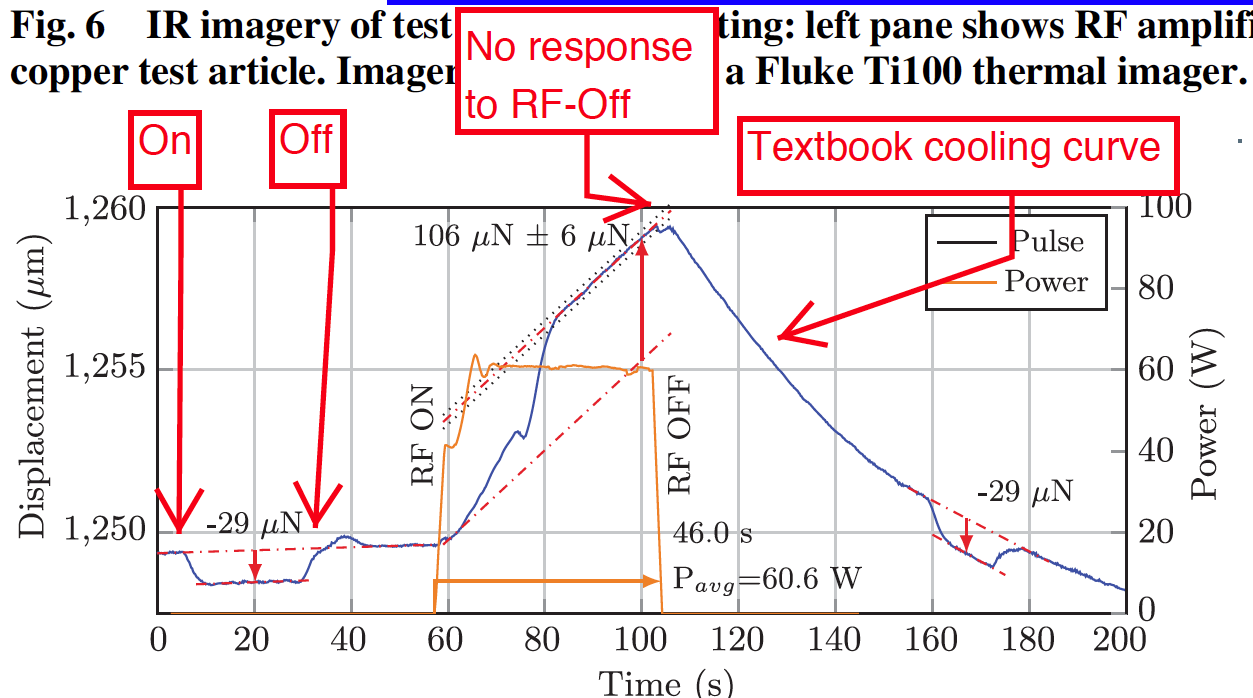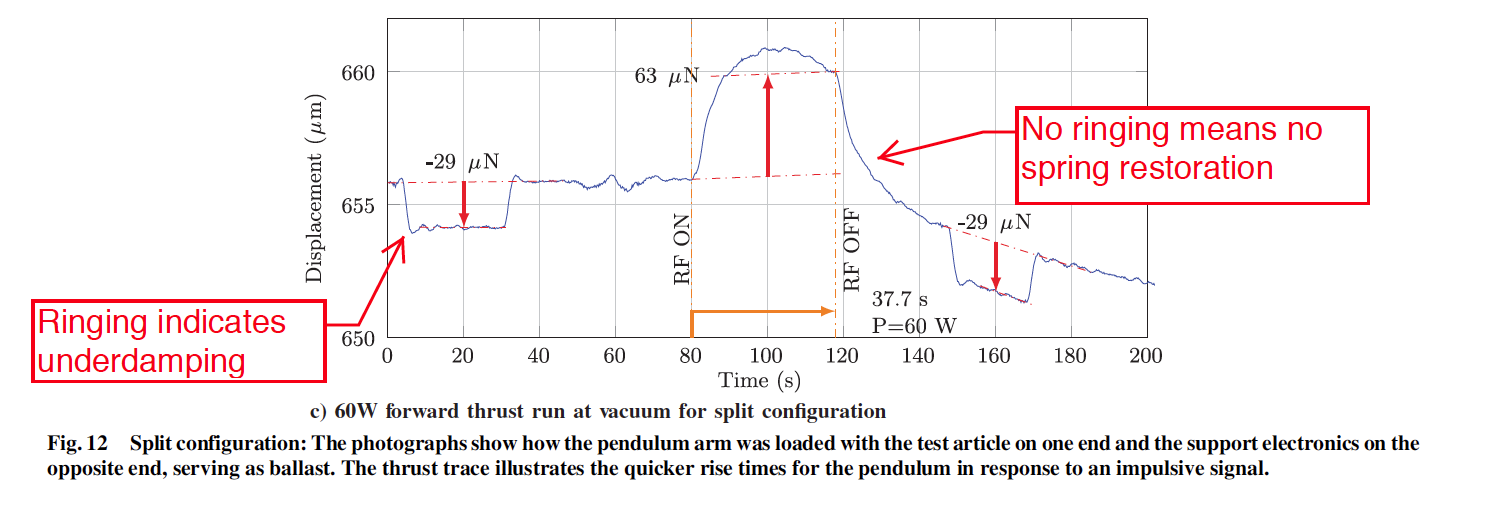Possible explanation for EmDrive test results
This is just a comment on reddit. But it seemed to me very interesting, and I did not see any references in the Russian-language discussions. Paragraphs marked with TL; DR are omitted.
Yes. Lot. But let us focus on one of them: according to my reading of the article, the data quite clearly show that the displacement measured by the authors is caused by thermal expansion, and not by the burden created by the cavity. Of course, I myself did not work with the device, and therefore I cannot say this with absolute certainty, but I am convinced, and I think that you should also be.

The thing is in this graph from the article that I have marked [Translator's Note: in the text of the label in English, so that you can compare]. Note the calibration pulse, the blue area between “On” and “Off”. It shows how the balancer responds to the applied force. Pay special attention to how quickly it returns to its original position after the end of the pulse. See how he bounces when power disappears? Here is a high-quality experiment: applied precisely known force and showed a reaction.
')
Now let's look at the radio frequency pulse that is used to power the EmDrive (the golden line in that figure). The authors focus on the beginning of this impulse, and I would like you to look at its end, which is labeled “No response to RF-Off” [No response to turning off RF ”]. See how the spring does not immediately return to its original position? Yes, the trail starts to fall, but too slowly for the spring to return. Instead, it is very likely that the impulse has heated something and after its end it slowly cools. Schedule directly from the textbook :

So, instead of the “new physical effect”, a simple explanation is that the impulse heats the equipment and changes the balance position of the balancer. I have to say that it is mentioned in their list of possible errors, and they try to reject this explanation, but you can see everything on the charts. Almost everyone does not have the quick return that should be.
Let's look at their attempt to reject this explanation and see that it only confirms it more strongly. They write that the system is set up to react slowly (at least fast or slow, this reaction speed should be the same for calibration and for the working pulse). In the earlier “split configuration” it was faster and Figure 12 from the article is an example of this. Let's take a look at it.

See the “ringing” (damped oscillations) at both ends of the calibration pulse (marked “Ringing indicates underdamping”)? It shows that the system is underdempted. This is good - as an experimenter, you prefer a quick reaction and are ready to pay for it with a small pulsation. And now look at the working impulse, or rather, at its end. No ringing! This is absolutely crucial evidence. This schedule alone is enough to throw out the whole experiment. Lack of a ring completely excludes return of spring system to balance. That is, when the EmDrive is turned on, it does not stretch the spring. Their experiment strictly proved that EmDrive does not create traction!
Figure 12 is a decisive proof that whatever moves when you start the EmDrive is not the system that is designed to measure thrust. They measure not what they think.
A few last notes. First, White should have published the full experimental data. I was accused of being too shallow. If we had the raw data, we could do accurate calculations, create IPython notebooks, everyone could see the analysis and discuss it quantitatively, not qualitatively. The article has little data, so the problem is not on my side. It would be useful for everyone.
Secondly, here is a small list of improvements that I would suggest to anyone who wants to reproduce the experiment. They will allow you to directly refute this explanation. [Translator's note: the translation of paragraphs after the first is based on the options proposed by the Fullmoon commentator .]
NASA published an article entitled "Measurement of Impulsive Thrust from a Closed Radio-Frequency Cavity in Vacuum" in a peer-reviewed journal. Does it have serious shortcomings?
Yes. Lot. But let us focus on one of them: according to my reading of the article, the data quite clearly show that the displacement measured by the authors is caused by thermal expansion, and not by the burden created by the cavity. Of course, I myself did not work with the device, and therefore I cannot say this with absolute certainty, but I am convinced, and I think that you should also be.

The thing is in this graph from the article that I have marked [Translator's Note: in the text of the label in English, so that you can compare]. Note the calibration pulse, the blue area between “On” and “Off”. It shows how the balancer responds to the applied force. Pay special attention to how quickly it returns to its original position after the end of the pulse. See how he bounces when power disappears? Here is a high-quality experiment: applied precisely known force and showed a reaction.
')
Now let's look at the radio frequency pulse that is used to power the EmDrive (the golden line in that figure). The authors focus on the beginning of this impulse, and I would like you to look at its end, which is labeled “No response to RF-Off” [No response to turning off RF ”]. See how the spring does not immediately return to its original position? Yes, the trail starts to fall, but too slowly for the spring to return. Instead, it is very likely that the impulse has heated something and after its end it slowly cools. Schedule directly from the textbook :

So, instead of the “new physical effect”, a simple explanation is that the impulse heats the equipment and changes the balance position of the balancer. I have to say that it is mentioned in their list of possible errors, and they try to reject this explanation, but you can see everything on the charts. Almost everyone does not have the quick return that should be.
Let's look at their attempt to reject this explanation and see that it only confirms it more strongly. They write that the system is set up to react slowly (at least fast or slow, this reaction speed should be the same for calibration and for the working pulse). In the earlier “split configuration” it was faster and Figure 12 from the article is an example of this. Let's take a look at it.

See the “ringing” (damped oscillations) at both ends of the calibration pulse (marked “Ringing indicates underdamping”)? It shows that the system is underdempted. This is good - as an experimenter, you prefer a quick reaction and are ready to pay for it with a small pulsation. And now look at the working impulse, or rather, at its end. No ringing! This is absolutely crucial evidence. This schedule alone is enough to throw out the whole experiment. Lack of a ring completely excludes return of spring system to balance. That is, when the EmDrive is turned on, it does not stretch the spring. Their experiment strictly proved that EmDrive does not create traction!
Figure 12 is a decisive proof that whatever moves when you start the EmDrive is not the system that is designed to measure thrust. They measure not what they think.
A few last notes. First, White should have published the full experimental data. I was accused of being too shallow. If we had the raw data, we could do accurate calculations, create IPython notebooks, everyone could see the analysis and discuss it quantitatively, not qualitatively. The article has little data, so the problem is not on my side. It would be useful for everyone.
Secondly, here is a small list of improvements that I would suggest to anyone who wants to reproduce the experiment. They will allow you to directly refute this explanation. [Translator's note: the translation of paragraphs after the first is based on the options proposed by the Fullmoon commentator .]
- Take temperature data in real time. Place the sensors wherever possible. Thermocouples are very light and cheap. This will allow to quantify the thermal expansion.
- Use a different type of suspension, as the current can mix vertical and horizontal movements.
- To stabilize the oscillator frequency by feedback (using the Pound – Drever – Hall method)
- To reduce temperature drops, do not turn off the generator, but switch the radiation between the cavity and the cap.
- Use synchronous gain .
Source: https://habr.com/ru/post/370029/
All Articles